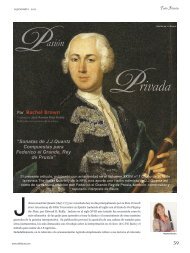Telemann Fantasias article + music - Rachel Brown
Telemann Fantasias article + music - Rachel Brown
Telemann Fantasias article + music - Rachel Brown
Create successful ePaper yourself
Turn your PDF publications into a flip-book with our unique Google optimized e-Paper software.
and extra roulades (ex.5) whereas some of the short improvisatory fragments might<br />
lend themselves more to the Italian-style melismas of irregular number of notes under<br />
a slur.<br />
Alla Francese<br />
" !<br />
# #<br />
" # #<br />
$!<br />
Ti<br />
ri di-ri-d'l di<br />
%<br />
$ $ $ $ $!<br />
$ $<br />
$!<br />
di - dl - di di - d'l Ti<br />
$ $$ $ $ $ '$<br />
$ $ $ $ $ $ $! $<br />
ti-ri-d'l di-d'l di-d'l di<br />
%<br />
$ $ $ $ $!<br />
ti - d'l di<br />
$ ( $ $$ $ $ $ '<br />
ti - ri di-ri-d'l di<br />
$ $<br />
$<br />
di - d'l di<br />
Ex.5 <strong>Telemann</strong> Fantasia in D major, Alla Francese, bars 1-6<br />
&$!<br />
$<br />
ti<br />
ti-ri-d'l di-d'l di-d'l di<br />
$! $<br />
$! $<br />
ti - ri ti - ri ti -<br />
$ $ $ $ $ $ $ $! $ &<br />
$ ( $ # $$ $ # $ $<br />
ti - ri ti-ri- d'l di<br />
The German style of ornamentation is governed by the harmony: any notes of the<br />
same harmony may be added (or taken away) and any passing notes introduced must<br />
be properly prepared and resolved. German ornamental figures are characterised by<br />
detailed articulation (harmony notes can be tongued or slurred whilst passing notes<br />
must be slurred from or onto harmony notes), rhythmic variety (triplets, demi-semiquavers,<br />
Lombardic snaps and syncopation) and nuances (Quantz indicated<br />
ornamental notes often softer than the main notes).<br />
The Adagio of the A minor Fantasia is a fully ornamented movement in the German<br />
style and in that sense, it needs no additional embellishment; <strong>Telemann</strong>’s <strong>music</strong> is<br />
lovely as it stands yet if one wanted to ornament here, it would be more a case of<br />
exchange, paring the <strong>music</strong> down to its basic framework before adding new ideas. Ex.<br />
6 suggests possibilities incorporating some of <strong>Telemann</strong>’s hallmarks; a turn-type<br />
figure on the first note, many harmony notes, passing notes with slurs, an occasional<br />
unprepared dissonance, a multitude of rhythms and early entry of the following<br />
upbeat. The opening of this movement bears striking resemblance to the C major<br />
Methodical Sonata <strong>Telemann</strong> (published just a few years later) and this has been<br />
included here for comparison. When adding many notes one must never lose sight of<br />
the character!




